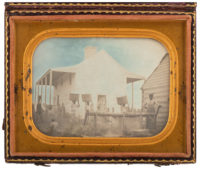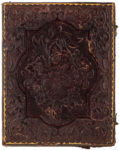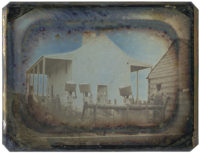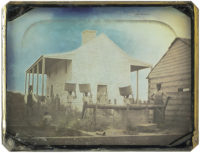 The only known antebellum image of enslaved African-Americans with cotton has been acquired by the Hall Family Foundation for the Nelson-Atkins Museum of Art in Kansas City, Missouri. The quarter plate daguerreotype was sold at Cowan’s American History auction in Cincinnati, Ohio, on November 15th and blew past the pre-sale estimate of $100,000 – $150,000 for a hammer price of $260,000 ($324,500 including buyer’s premium).
The only known antebellum image of enslaved African-Americans with cotton has been acquired by the Hall Family Foundation for the Nelson-Atkins Museum of Art in Kansas City, Missouri. The quarter plate daguerreotype was sold at Cowan’s American History auction in Cincinnati, Ohio, on November 15th and blew past the pre-sale estimate of $100,000 – $150,000 for a hammer price of $260,000 ($324,500 including buyer’s premium).
 The daguerreotype, still in its original leather case, was taken in the 1850s and is a posed tableau centered on three slaves carrying large baskets of cotton on their heads. In total there are 10 African-American enslaved individuals in the image, including several children. Behind them is a two-story house with front and rear galleries supported by posts. A log cabin is in the front right, perhaps a smokehouse or slave cabin. A crude well with a large timber crank mechanism is in the front center. A man in a top hat on the left is likely the owner.
The daguerreotype, still in its original leather case, was taken in the 1850s and is a posed tableau centered on three slaves carrying large baskets of cotton on their heads. In total there are 10 African-American enslaved individuals in the image, including several children. Behind them is a two-story house with front and rear galleries supported by posts. A log cabin is in the front right, perhaps a smokehouse or slave cabin. A crude well with a large timber crank mechanism is in the front center. A man in a top hat on the left is likely the owner.
Images of enslaved people working on the cotton plantations of Georgia and the Carolinas are extant, but they were captured by photographers who traveled south with the Union Army. They were taken at the large coastal planters owned by the wealthiest elites and worked by hundreds of slaves. This daguerreotype depicts slavery at a rural holding, the type of small-scale operation that was typical for the vast majority of slaveholders.
The daguerreotype was discovered in estate of Charles Gentry, Jr., after his death in Austin, Texas, in 2012. It was in good condition, but needed conservation to remove tape residue and dirt and to re-glaze and rebind the plate. The hinges of the case were also repaired.


Gentry was originally from Polk County, Georgia, so researchers investigated the origin of the image, they turned to the census and Slave Schedule records pertaining to the Gentry family in Georgia. Of several Gentrys living in Georgia in the decade before the Civil War, only one owned at least 10 slaves: Samuel T. Gentry of Greene County. The Federal Slave Schedules list him as owning between 15 and 18 men, women and children between 1850 and 1860.
“This piece—a record of the historical crime of slavery—is remarkable both for the power of its content and for its technical and aesthetic sophistication,” said [Keith F. Davis, Senior Curator, Photography, Nelson-Atkins Museum of Art]. “This is an unforgettable rendition of an era, and a way of life, that must never be forgotten or forgiven. At the same time, it markedly expands our understanding of the history of American photography. We have long believed that daguerreotypes such as this ‘should’ have been made in the 1850s; now we know that at least one actually was.”
A ‘Blacks on White’ daguerreotype, and there is ‘Blues’ too :no:
The ‘Encomiendas’ was a Spanish labor system rewarding conquerors with the labor of particular groups of people. The Crown awarded a particular encomienda to a particular individual. The scope of the Laws of Burgos (“Leyes de Burgos”) of 1512 declared that the Indians were free men and that law had originally been restricted to the island of Hispaniola but was later extended to Puerto Rico and Jamaica. The Leyes Nuevas (“New Laws”) in 1542 at least tried to set stricter regulations about life in the New World. Later, however, the introduction of “official” slavery had actually been an improvement for everyone, i.e. notably except the imported Blacks. That some of them were sold to what later became the US, is probably coincidence.
Conquistador Nick Federmann (a.k.a. Nicolás de Federmán), on his way to “Little Venice” (Venezuela), visited Hispaniola in 1529 and noticed:
——–
“To describe the customs and traditions of the ‘naturales’ in that country is futile, since it has been subjected by Christians 40 years ago, and as everybody knows, these are naked people of the same colour as they are in Coro [in Venezuela]. They, i.e. the ‘naturales’ or inhabitants that owned the island before the Christians came, by now do not have villages of their own, but instead are complete subjects and servants to the Christians, but only as far as they are still alive. However, there are not many of them left. It is understood that of the 500.000 Indios or inhabitants that were in that country of several nations and languages, i.e. until the Christians discovered it 40 years ago, not more that 20.000 are still alive. A large fraction is said to have died from an illness that they call ‘viroles’, but also has to a certain extent died in armed conflict. However, a large share also died from excessive labour, enforced by the Christians in the gold mines, which these people are obviously not suited for, as they are tiny, had formerly not been hard workers and are rather weak…”
——–
(From: “Indianische Historia. Ein schöne kurtzweilige Historia Niclaus Federmanns des Jüngern von Ulm erster raise”, Hagenau 1557. Federmann himself died in February 1542 in a Spanish prison in Valladolid)
The building in the right foreground is possibly the summer kitchen. Too hot to cook in the main house in the warm months. The well was conveniently close.
The slave quarters likely would be out of sight of the main house.
“never forgiven” Pretty harsh. How long is never?” “Yea, unto the seventh generation?”
My understanding is the vast majority of slaves in the American south were owned by about 10,000 slave holding families, the 1%ers of the time, that owned the vast majority of everything back then, just as they do today. Some middle or upper middle class families had a slave or a few, but overwhelming, most southerners didn’t have slaves. Most whites were dirt poor, which makes sense, because the slave economy rendered their labor nearly worthless, just as in Ancient Rome, the plebs had their free bread and circuses as foreign slave labor did all the real work. They were willing to fight for the confederacy quite simply because many of them had nothing better to do with their time and going to war is an adventure many young men have undertaken throughout history.
This was purchased at a yard sale a few months ago, it was found at the bottom of a box of frames. Curiously, the Facebook posting relating this discovery appears to have been deleted. I remember when the lucky buyer asked – to a photography history Facebook group – ‘is this valuable’?
A pity the curator felt the need to virtue-signal so hard. It may reduce the likelihood of others being willing to come forward with similar material.